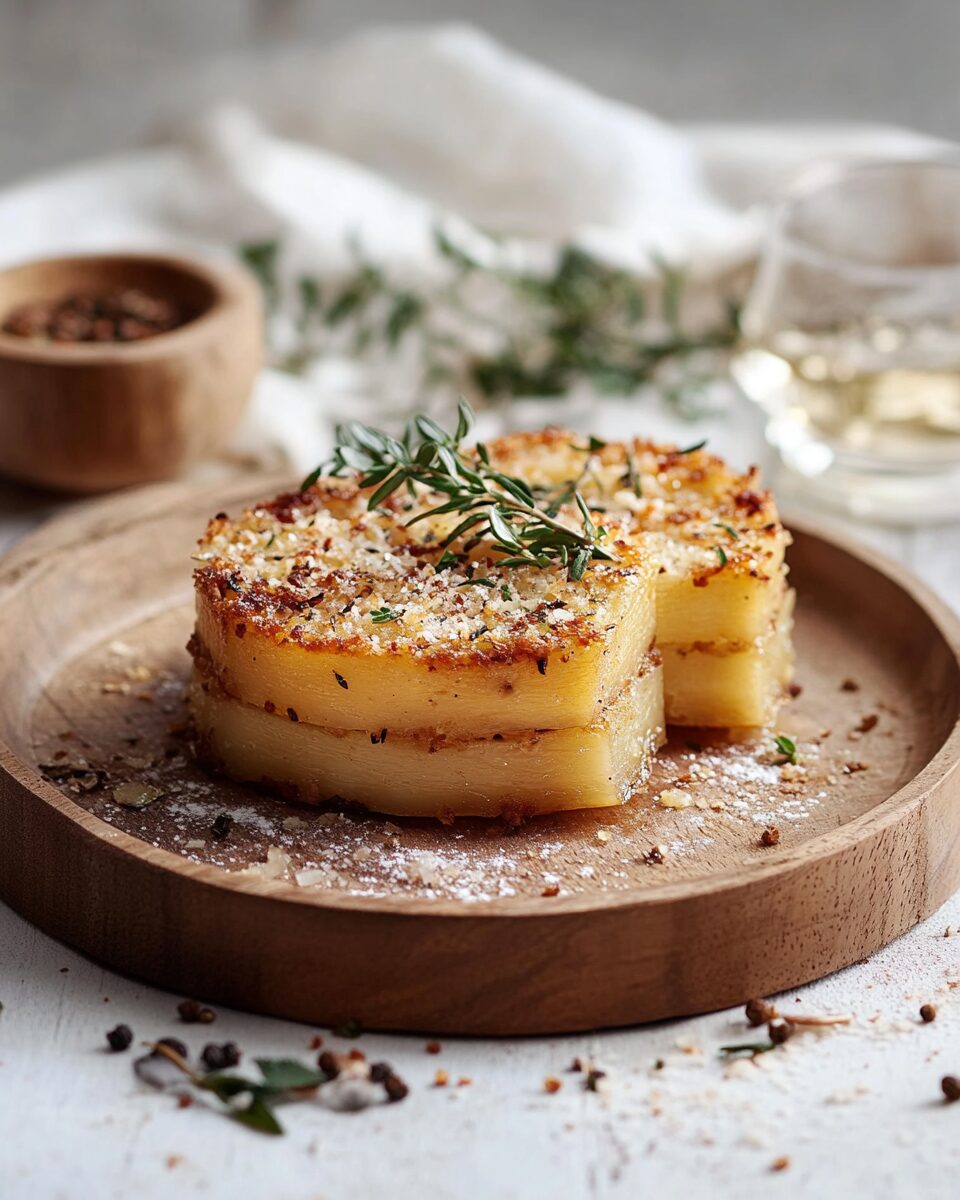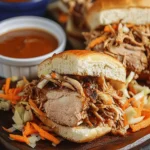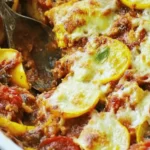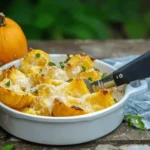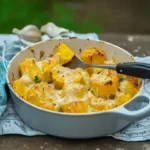Potato Pavé is a classic French dish that transforms simple potatoes into an elegant and flavorful side. This recipe involves layering thinly sliced potatoes with cream and butter, then baking and pressing them to achieve a tender interior and a crispy, golden exterior.
FULL RECIPE:
Ingredients
- 3 lbs russet potatoes (preferably three 1-lb potatoes)
- 1 cup heavy cream
- 5 tablespoons unsalted butter (1 tablespoon softened, 4 tablespoons cut into ½-inch cubes)
- Canola oil
- 2 thyme sprigs
- 2 cloves garlic, crushed
- Minced fresh chives
- Sel Magique Spicy Blend (or substitute with a mix of sea salt and preferred spices)
- Black pepper
Directions
- Preheat the oven to 350°F (175°C).
- Prepare the cream mixture: In a large bowl, pour the heavy cream and season with ½ teaspoon of Sel Magique Spicy Blend and ½ teaspoon of black pepper.
- Slice the potatoes: Peel the potatoes and trim them into rectangular shapes. Using a mandoline, slice the potatoes lengthwise into very thin slices. As you slice, add them to the cream mixture, tossing occasionally to prevent oxidation.
- Prepare the baking pan: Brush half of the softened butter onto a 10-by-5-by-2¾-inch baking pan. Line the pan with parchment paper, leaving a 5-inch overhang on all sides. Brush the parchment with the remaining softened butter and lightly sprinkle with Sel Magique Spicy Blend.
- Layer the potatoes: Arrange trimmed potato slices to form an even layer at the bottom of the pan. Repeat to create a second layer, then dot with a few butter cubes and lightly season with Sel Magique. Continue this process—layering potatoes, adding butter, and seasoning after every two layers—until the pan is filled. Fold the parchment overhang over the potatoes and cover tightly with aluminum foil.
- Bake: Place the covered pan in the oven and bake until the potatoes are completely tender when pierced with a knife, about 1 hour and 50 minutes.
- Press and chill: Remove from the oven and let cool for 15 minutes. Cut a piece of cardboard slightly smaller than the pan size, wrap it in aluminum foil, and place it on top of the potatoes. Weight it down with heavy cans to compress the layers and let cool to room temperature. Then, remove the weights, wrap the pan tightly, and refrigerate for at least 6 hours or overnight.
- Cut and prepare for serving: After chilling, run a spatula between the parchment and pan to release the pave. Using the parchment overhang, lift the pave out or invert it onto a cutting board. Trim the sides and cut into 12 equal pieces. Let them stand at room temperature for 30 minutes.
- Sauté for serving: Heat a large skillet over medium-high heat and add enough canola oil to coat the bottom. When the oil is hot, add the potato pieces cut-side down, along with thyme sprigs and crushed garlic. Cook, basting with oil, until browned on one side. Carefully turn and brown the opposite side.
- Serve: Transfer the browned potato pavé pieces to a serving platter, arranging them browned side up. Garnish with minced fresh chives and a sprinkle of Sel Magique Spicy Blend.
Nutrients
- Calories: Approximately 200 kcal
- Total Fat: 12 g
- Saturated Fat: 7 g
- Cholesterol: 35 mg
- Sodium: 50 mg
- Total Carbohydrates: 20 g
- Dietary Fiber: 2 g
- Sugars: 1 g
- Protein: 3 g
Why Potato Pavé Stands Out
Potato Pavé’s appeal lies in its texture and taste. The internal structure is velvety and rich, while the outer layer provides a satisfying crunch. Unlike traditional mashed or roasted potatoes, this dish combines the best of both worlds. The compression technique used during the chilling process ensures each layer remains intact, resulting in a beautifully layered effect when cut. This makes Potato Pavé not only delicious but also visually stunning. Another aspect that makes Potato Pavé unique is its versatility. It pairs well with a variety of main courses, including steak, roasted chicken, or grilled seafood. The creamy interior absorbs the flavors of any accompanying sauce or gravy, making it an ideal side dish for both meat and vegetarian entrees. Additionally, the ability to prepare the dish ahead of time allows for stress-free entertaining.
The Role of Ingredients
While the ingredient list for Potato Pavé is simple, each component plays a crucial role in achieving the desired result. High-quality russet potatoes are often preferred due to their starchy content, which contributes to the dish’s signature creaminess. Heavy cream and butter add richness and depth of flavor. Seasonings like Sel Magique Spicy Blend or sea salt, along with fresh herbs such as thyme, elevate the taste profile and add a fragrant aroma. Garlic is often infused into the butter, imparting a subtle yet delicious flavor. Some variations may include cheese, particularly Gruyère or Parmesan, for an extra layer of complexity. The use of canola oil during the final searing step ensures a crispy, golden crust without overpowering the dish.
Perfecting the Technique
Achieving the perfect Potato Pavé requires careful attention to each step of the cooking process. The thin slicing of potatoes using a mandoline ensures uniformity, leading to even cooking. Each layer must be meticulously arranged and seasoned to enhance the flavor throughout. Once the layers are complete, the parchment-lined baking pan aids in the easy removal and cutting of the dish after chilling. Compression is a critical step in this recipe. By placing a weighted object on top of the baked potatoes as they cool, the layers are firmly pressed together. This creates the distinctive dense and uniform appearance when sliced. The chilling process, typically done overnight, further solidifies the structure, making the searing step more effective.
Customization and Variations
While the traditional version of Potato Pavé is undoubtedly luxurious, it also offers room for creativity. Adding cheese between the layers or incorporating truffle oil can provide a gourmet twist. For a lighter option, substituting part of the heavy cream with whole milk can reduce the richness without sacrificing the creamy texture. Vegetable variations are another popular choice. Sweet potatoes, parsnips, or even a combination of root vegetables can be used to create a colorful and nutrient-rich alternative. Additionally, experimenting with herbs and spices, such as rosemary, nutmeg, or smoked paprika, can offer unique flavor profiles suited to different cuisines. For those seeking a healthier version, baking with olive oil instead of butter and using a dairy-free cream substitute can accommodate dietary restrictions. Vegan adaptations often involve plant-based cream and butter alternatives, providing a satisfying and inclusive option.
Serving Suggestions
Potato Pavé’s elegant appearance makes it a showstopper on any dining table. Serve it as a refined side dish alongside prime rib, roasted turkey, or glazed ham for festive occasions. It also pairs well with grilled salmon or seared scallops, creating a balanced and luxurious meal. For a complete vegetarian meal, consider pairing Potato Pavé with a fresh arugula salad dressed with lemon vinaigrette and shaved Parmesan. Additionally, it complements roasted vegetables, sautéed greens, or a creamy mushroom sauce for a comforting and satisfying experience. To elevate the presentation, garnish with fresh chives or parsley for a pop of color. Serving it on a rustic wooden board or a sleek, modern plate can further enhance its visual appeal.
Conclusion
Potato Pavé is a culinary delight that embodies the elegance of French cuisine. Its combination of crispy edges, creamy layers, and rich flavors makes it a memorable addition to any meal. While the process requires some patience and precision, the results are undeniably rewarding. Whether served at a formal dinner party or as a luxurious side for a family gathering, Potato Pavé brings sophistication and comfort to the table. By mastering this dish, you not only gain a valuable culinary skill but also the ability to impress guests with a visually stunning and delicious creation.

